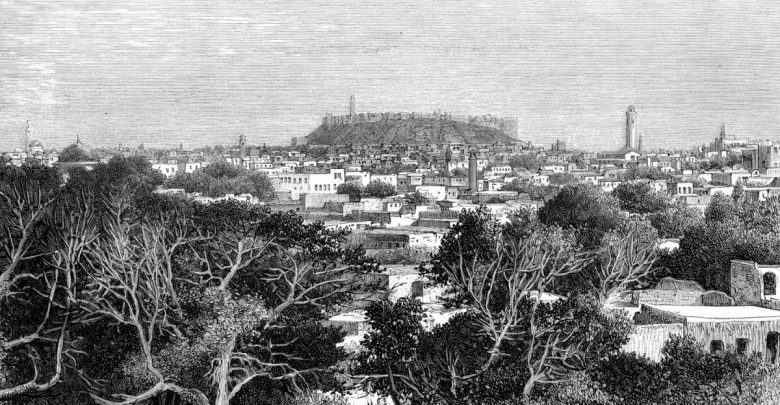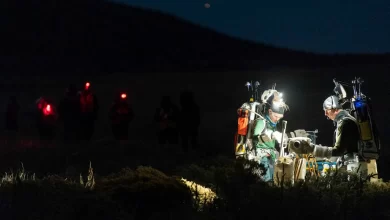
Top Deadliest Natural Disasters in History
أسوأ الكوارث التي حدثت في تاريخ البشرية
Violent natural disasters have been a fact of human life since the beginning of the species, but the death counts of the most ancient of these disasters are lost to history. The Mediterranean island of Stroggli, for example, is believed to have been completely wiped out by a volcanic eruption and ensuing tsunami that eradicated the entire Minoan civilization around 1500 B.C. How many lives were lost? We’ll never know.
For other disasters, historians can at least make estimates. The following 11 disasters are the deadliest for which reasonably accurate death tolls exist. The lesson? While the chaos of a natural disaster can mean exact numbers are hard to come by, earthquakes and floods are the disasters most likely to kill large swaths of the population.
1138 Aleppo earthquake – maybe
On Oct. 11, 1138, the ground under the Syrian city began to shake. The city sits on the confluence of the Arabian and African plates, making it prone to temblors, but this one was particularly nasty. The magnitude of the quake is lost to time, but contemporary chroniclers reported that the city’s citadel collapsed and houses crumbled across Aleppo. The death toll of this quake is typically put at about 230,000, but that estimate comes from the 15th century, and the historian may have been conflating the Aleppo quake with another one in Georgia, according to a 2004 paper in the Annals of Geophysics.
2010 Haiti quake
If Aleppo’s death toll is mistaken, the earthquake that hit Haiti on Jan. 12, 2010, may be a contender for the top 10 deadliest disasters. Even in a modern mass disaster, though, estimating the death toll is a tricky business.
In the year after the quake, the government of Haiti estimated that the magnitude-7.0 quake and its aftermath killed 230,000 people; in January 2011, officials revised the figure to 316,000. Those figures are highly disputed, however. A 2010 study published in the journal Medicine, Conflict and Survival put the number at around 160,000 deaths. A 2011 U.S. Agency for International Development (USAID) draft report from 2011 claimed even lower numbers — between 46,000 and 85,000.
The disparities reflect the difficulty of counting deaths even in the modern era, not to mention the political wrangling that goes on over “official” numbers. Many critics of Haiti’s estimates argue that the government revised the death toll up in order to secure further international aid. On the other side of the argument, according to the Columbia Journalism Review, were those who accused USAID of leaking the report to discredit the Haitian government.
2004 Indian Ocean earthquake and tsunami
A magnitude-9.3 temblor struck undersea off the west coast of Sumatra on Dec. 26, 2004, creating a massive tsunami that killed people in 14 separate countries. The overall death toll is estimated at between 230,000 and 280,000 people. In some places, especially hardest-hit Indonesia, the tsunami wave reached 98 feet (30 meters) in height. Indonesia had the highest death toll of any country, with 126,473 confirmed dead and 93,943 missing, according to official government figures. Sri Lanka followed, with a total of 36,594 dead or missing.
1920 Haiyuan earthquake
On Dec. 16, 1920, a strong earthquake hit Haiyuan Country in central China. According to a 2010 study presented at a conference in honor of the quake’s 90th anniversary, 273,400 people died in the quake, most buried in landslides caused by the ground shaking.
According to the U.S. Geological Survey (USGS), the quake was probably a magnitude 7.8 and was felt all the way from the Yellow Sea to Qinghai Province on the Tibetan plateau. The National Oceanic and Atmospheric Administration (NOAA) records show that the quake destroyed four cities and buried multiple towns and villages.
1976 Tangshan earthquake
At 3:42 a.m. on July 28, 1976, the Chinese city of Tangshan and its surroundings were rocked by a magnitude-7.8 earthquake. Tangshan, an industrial city, had a population of about a million people, and the official death toll was a staggering 255,000. Another 700,000 people were injured, according to “The Great Tangshan Earthquake of 1976: An Anatomy of Disaster” (Pergamon Press, 1988). Many of Tangshan’s buildings were completely destroyed, according to that history, and 150,000 people got new residences in the six years following the quake.
526 Antioch earthquake
As with all historical quakes, precise death tolls for the Antioch earthquake of A.D. 526 are hard to come by. But contemporary chronicler John Malalas wrote at the time that about 250,000 people died when the temblor hit the Byzantine city in May of that year. Malalas attributed the disaster to the wrath of God and reported that fires destroyed everything in Antioch that the earthquake itself did not.
According to a 2007 paper in The Medieval History Journal, the death toll was higher than it would have been at other times of the year because the city was full of tourists celebrating Ascension Day.
1839 India cyclone/1881 Haiphong typhoon
The Coringa cyclone of 1839 hit the port city of Coringa on Nov. 25, whipping up a storm surge of 40 feet (12 meters), according to the NOAA Atlantic Oceanographic and Meteorological Laboratory Hurricane Research Division. About 20,000 ships and vessels were destroyed, along with the lives of an estimated 300,000 people.
Also vying for the No. 5 spot on the list by death toll is an 1881 typhoon that hit Haiphong, Vietnam, on Oct. 8. That storm is also estimated to have killed about 300,00 people.
The 1970 Bhola cyclone
Another storm that wiped out tens of thousands of lives was the Bhola cyclone of Nov. 12, 1970. This storm struck what is now Bangladesh (then East Pakistan), pushing up a 20-foot storm surge that funneled right over the low terrain bordering the Bay of Bengal, causing widespread flooding. A 1971 report from the National Hurricane Center and the Pakistan Meteorological Department acknowledged the challenge of accurately estimating the death toll, especially due to the influx of seasonal workers who were in the area for the rice harvest. However, most estimates place the loss of life from the Bhola cyclone at 300,000 at the low end, ranging up to 500,000.
1556 Shaanxi earthquake
The deadliest earthquake in history hit China’s Shaanxi province on Jan. 23, 1556. Known as the Jiajing Great Earthquake after the emperor whose reign it occurred in, the temblor reduced a 621-square-mile (1,000 square kilometers) swath of the country to rubble, according to the Science Museums of China. An estimated 830,000 people died as their homes collapsed and fires raged after the quake. The exact magnitude of the quake is lost to history, but modern-day geophysicists estimate it at around magnitude 8.
The 1887 Yellow River Flood
The Yellow River (Huang He) in China was precariously situated far above most of the land around it in the late 1880s, thanks to a series of dikes built to contain the river as it flowed through the farmland of central China. Over time, these dikes had silted up, gradually lifting the river in elevation. When heavy rains swelled the river in September 1887, it spilled over these dikes into the surrounding low-lying land, inundating 5,000 square miles (12,949 square kilometers), according to “Encyclopedia of Disasters: Environmental Catastrophes and Human Tragedies” (Greenwood Publishing Group, 2008).
The estimated death toll of the flood is 900,000.
لطالما هددت الكوارث الطبيعية والأوبئة تاريخ البشرية وأسهمت في تغيير جغرافيا وديموغرافيا البلدان التي حلت بها كما غيرت مجرى تاريخ العالم،وقد كان للمنطقة العربية أيضا نصيبا من هذه الكوارث فإليكم أسوأ الكوارث التي تسببت بها الطبيعة والأوبئة
زلزال مصر وسوريا عام 1201
تعرضت منطقة بلاد الشام عام 1202 لكارثة ليس لها مثيل ، عندما ضرب زلزال مُدمر شرق المتوسط و قد شمل تأثير الزلزال كافة مناطق بلاد الشام و مصر ، ووصل الشعور به حتى ارمينيا و تركيا و جزيرة صقلية في البحر المتوسط.ودمر الزلزال مناطق كبيرة من البلدين وراح ضحيته أكثر من مليون و100 ألف شخص في مُختلف أنحاء بلاد الشام بحسب بعض الدراسات.
زلزال شانشي في الصين عام 1556
الزلزال الأكبر من حيث عدد الضحايا والذي بلغ نحو 830 ألف ضحية حدث هذا الزلزال عام 1556م في مقاطعة شانشي الصينية وبلغ تأثيره إلى أكثر من سبعة وتسعين مقاطعة من مقاطعات شانشي حيث بلغت قوته ثماني درجات على مقياس ريختر وأدى إلى مقتل ستين بالمائة من سكان المقاطعة، حيث كان أغلب السكان في ذلك الوقت يسكنون في كهوف اصطناعية وفي شقوق الجبال التي انهارت عليهم نتيجة الكارثة.
المجاعة الكبرى في الهند 1769-1773
في عام 1769 تعرضت الهند لأسوأ مجاعة مسجلة في التاريخ وقد راح ضحيتها حوالي 10 ملايين شخص وخلفت هذه المجاعة دمارا طال ثلث سكان البنغال ، بسبب الجفاف الحاد الذي أتلف المحاصيل الزراعية في 4 سنوات متتالية
وفي تفاصيلها، تجلت أولى مؤشرات هذه المجاعات في عام 1769، وكانت مجاعة وحشية، امتدت حتى عام 1773.
إعصار كورينغا في الهند عام 1839
بأمواج مصحوبة ارتفاعها 12 مترًا، ضرب إعصار “كورينجا” الهند، في 5 نوفمير من عام 1839، وتسبب في مقتل 300 ألف شخص تقريبًا، وتدمير 20 ألف سفينة، وغرق 20 ألف شخص في مياه البحر، وقد ابتلعت الأرض معظم الضحايا جراء تحطم المنازل والأبنية.
مجاعة البطاطا في أيرلندا 1845-1852
.سميت أيضا بمجاعة ايرلندا الكبرى وتسببت بوفاةَ مليون إنسان وهجرة مليون آخر فانخفضت نسبة السكان بحوالي 20 بالمئة عندما أتلفت آفة زراعية تُسمى باللفحة المتأخرة محاصيل البطاطس في أنحاء أوروبا ، لكن الضرر كان كبيرا على أيرلندا بشكل خاص إذ كان ثلث سكانها يعتمد على أكل البطاطس في التغذية بسبب الفقر، فتفاقمت فيها الخسائر البشرية بل وغيرت هذه المجاعة المشهد السكاني والسياسي والثقافي في أيرلندا إلى الأبد وأصبحت نقطة تاريخية فاصلة في تاريخها.
الجفاف الكبير في الصين 1876-1879
خلال 3 سنوات فقط فقدت الصين معظم ما لديها من محاصيل زراعية وأعداد مهولة من الماشية بسبب موجة من الجفاف ضربت الصين عام 1876 وراح ضحيتها ما يقرب من تسعة ملايين شخص.
إعصار بولا 1970
من أعنف الأعاصير الاستوائية التي سجلها التاريخ على الإطلاق ،واحد أكبر الكوارث الطبيعية المميتة في التاريخ الحديث ضرب شرق باكستان (بنغلادش اليوم) وبنغال الغربية الهندية في 12 نوفمبر 1970وأدى إلى غرق معظم الجزر المنخفضة، كما أباد القرى ودمر المحاصيل في جميع أنحاء المنطقة ،وقدر عدد الضحايا بـ500 ألف شخص ولقي أغلبهم مصرعهم بسبب الطوفانات التي تبعت الإعصار.
فيضان النهر الأصفر في الصين 1887
وأيضا في الصين تسبب فيضان النهر الأصفر بمقتل حوالي 2.9 مليون نسمة اذ عتمد المزارعون المقيمون بالقرب من هذا النهر على السدود لتنظيم تدفق المياه، ولكن في 28 سبتمبر/ أيلول تمكنت الأمطار الغزيرة من التغلب على تلك السدود، مما أدى إلى فيضانات واسعة النطاق. بعد تحطيم السدود، انتشرت المياه بسرعة كبيرة في السهول المنخفضة وغطت حوالي 130 ألف كيلومتر مربع.
وباء الانفلونزا 1918-1919
هو فيروس قاتل وصف بأعظم هولوكوست طبي في التاريخ، انتشر في أعقاب الحرب العالمية الأولى العالم عبر الطرق الملاحية والتجارية و امتد ليطال معظم دول العالم وأودى بحياة 100 مليون شخص، أي حوالي خمسة بالمائة من سكّان العالم، بالإضافة إلى إصابة نصف مليار شخص به.
فيضانات الصين عام 1931
يُعد فيضان نهر يانغتسي بالصين عام 1931 أسوأ كارثة طبيعية في التاريخ، فقد خلَّفت وراءها 3.7 مليون شخصاً لقوا حتفهم نتيجة للغرق، والمرض، والجوع.
وكانت الصين شهدت فترة جفاف طويلة، الى أن بدأ الطقس يتغير في شتاء أواخر عام 1930، وتكاثرت العواصف الثلجية الغزيرة، تلى ذلك دفء الربيع، والأمطار الغزيرة مما أدى إلى ارتفاع منسوب المياه في نهر يانغتسي، وبدأ في الفيضان ، كما وصل عدد الأعاصير في المنطقة إلى تسعة أعاصير، في حين أن المتوسط إعصارين فقط.



